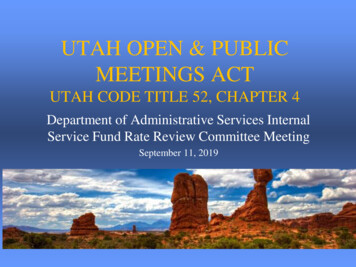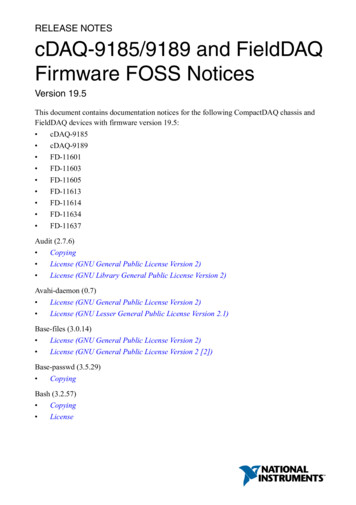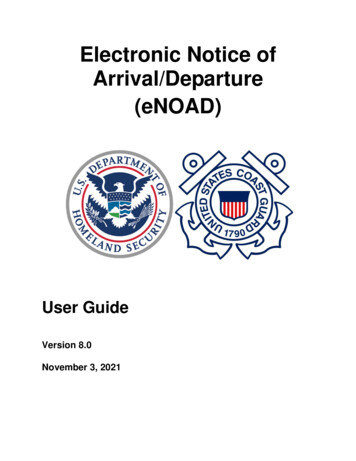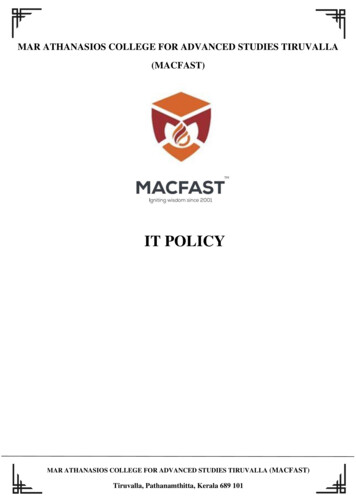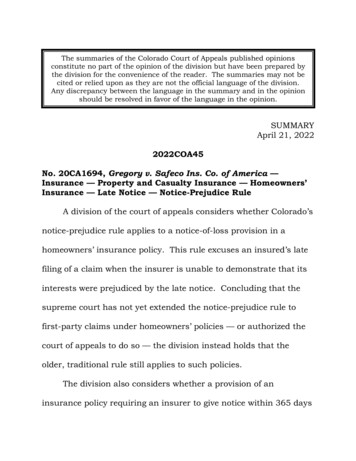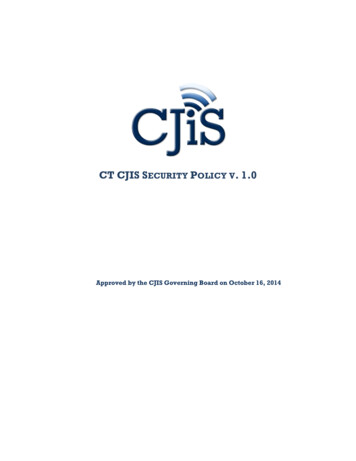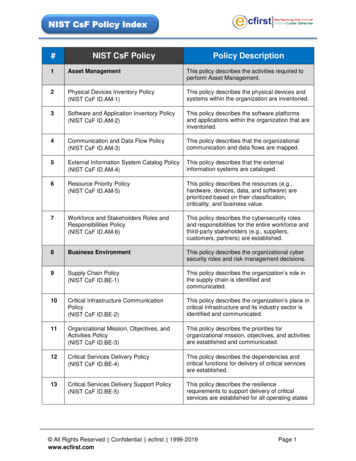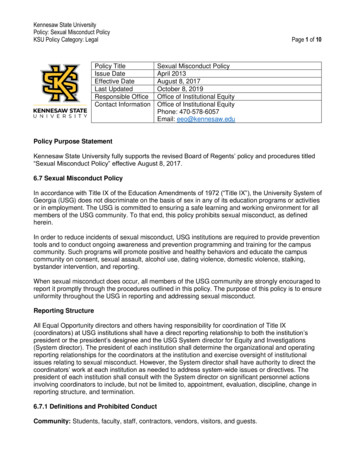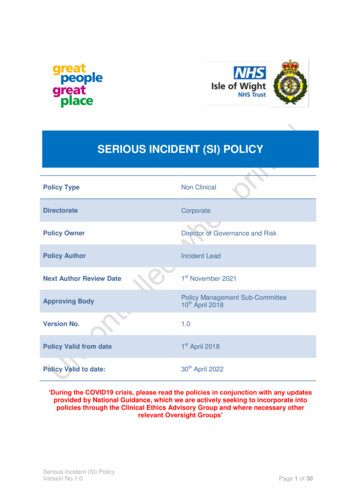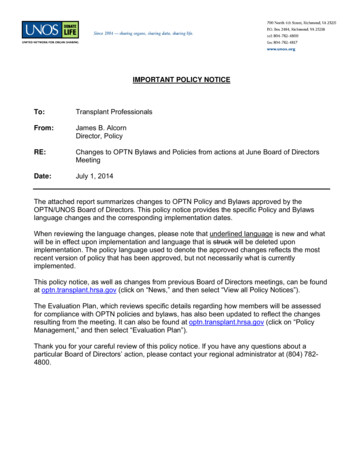
Transcription
IMPORTANT POLICY NOTICETo:Transplant ProfessionalsFrom:James B. AlcornDirector, PolicyRE:Changes to OPTN Bylaws and Policies from actions at June Board of DirectorsMeetingDate:July 1, 2014The attached report summarizes changes to OPTN Policy and Bylaws approved by theOPTN/UNOS Board of Directors. This policy notice provides the specific Policy and Bylawslanguage changes and the corresponding implementation dates.When reviewing the language changes, please note that underlined language is new and whatwill be in effect upon implementation and language that is struck will be deleted uponimplementation. The policy language used to denote the approved changes reflects the mostrecent version of policy that has been approved, but not necessarily what is currentlyimplemented.This policy notice, as well as changes from previous Board of Directors meetings, can be foundat optn.transplant.hrsa.gov (click on “News,” and then select “View all Policy Notices”).The Evaluation Plan, which reviews specific details regarding how members will be assessedfor compliance with OPTN policies and bylaws, has also been updated to reflect the changesresulting from the meeting. It can also be found at optn.transplant.hrsa.gov (click on “PolicyManagement,” and then select “Evaluation Plan”).Thank you for your careful review of this policy notice. If you have any questions about aparticular Board of Directors’ action, please contact your regional administrator at (804) 7824800.
Changes to Policies and Bylaws to Guide Vascularized CompositeAllograft (VCA) TransplantationSponsoring Committee: Vascularized Composite Allograft (VCA) CommitteePolicies affected: OPTN Policy 1.2 (Definitions) OPTN Policy 2.2 (OPO Responsibilities) OPTN Policy 2.12.C (Authorization Requirement) OPTN Policy 5.2 (Maximum Mismatched Antigens) OPTN Policy 5.4.B (Order of Allocation) OPTN Policy 5.5.A (Receiving and Reviewing Organ Offers) OPTN Policy 5.5.B (Time Limit for Acceptance) OPTN Policy 12.1 (Waiting Time) OPTN Policy 12.2 (VCA Allocation) OPTN Policy 14.6 (Registration and Blood Type Verification of Living Donors beforeDonation) OPTN Policy 18.1 (Data Submission Requirements) OPTN Policy 18.2 (Timely Collection of Data) OPTN Policy 18.3 (Recording and Reporting the Outcomes of Organ Offers) OPTN Bylaws, Appendix D (Membership Requirements for Transplant Hospitals andTransplant Programs) and D.2 (Designated Transplant Program Requirement) OPTN Bylaws, Appendix J (Membership Requirements for Vascularized Composite (VCA)Transplant Programs OPTN Bylaws, Appendix K (Transplant Program Inactivity, Withdrawal, and Termination) OPTN Bylaws, Appendix M (Definitions)Distribution for Public Comment: Pending fall 2014Amended After Public Comment: n/aEffective Date: July 3, 2014 through September 1, 2015Problem StatementThere are no formal policies or bylaws that establish key requirements for VCA recovery ortransplantation. Effective July 3, 2014, the OPTN will be responsible for oversight of VCArecovery and transplantation. As a result, substantial updates to the OPTN Policies andBylaws are required to: Define body parts covered by VCA policies.Establish VCA donor authorization requirements.Establish VCA allocation policies.Provide membership requirements for hospitals that perform VCA transplants.With the classification of VCA as an organ, interim solutions are required to collect VCAcandidate registrations and removals, and to facilitate VCA allocation. This is due tosignificant programming requirements to Wait ListSM, DonorNet , and Tiedi . As a result,several policy and bylaws requirements contain exemptions for VCA. Many of these
exemptions will be removed as elements pertaining to VCA recovery and transplantation areprogrammed and implemented.ChangesAll of the following changes are being made to OPTN Policies and Bylaws to establishrequirements for members wishing to participate in VCA recovery and transplantation: New content on VCA donor authorization was added to OPTN Policy 2. This waswritten to avoid conflicts with the Uniform Anatomical Gift Act, applicable state laws, orthe efforts of the donation community. New content on VCA allocation in OPTN Policy 12 ranks VCA candidates by waitingtime and compatible blood type. Allocation begins within the OPO’s region, then goesbeyond the OPO’s region. Bylaws Appendix D.2 was updated to reflect that a transplant hospital must haveapproval for a designated transplant program in addition to the VCA programdesignation. Bylaws Appendix J includes new content on membership requirements that outlinesspecific requirements of a VCA transplant program and the program’s letter of intent. Policy 1.2 and Bylaws Appendix M have been updated to include “vascularizedcomposite allografts” as an organ. Further, to be a VCA organ, a body part must meetall nine criteria from the Final Rule. These criteria appear in the definition of“Vascularized Composite Allograft."Member ActionsMembers are required to be familiar with and ensure compliance with the policies and bylawspertaining to VCA recovery and transplantation.Transplant programs must: Ensure that a body part they intend to transplant meets the criteria. This includes, butis not limited to, upper limbs, faces, and abdominal wall grafts. Prior to transplanting VCA organs, a transplant hospital must submit a letter of intent toperform such transplants to the OPTN Contractor in order to obtain VCA transplantprogram designation. The OPTN Contractor will notify the transplant hospital memberof the program designation. Email the OPTN Contractor at VCA@unos.org and request the necessary worksheetto register candidates on the VCA candidate list once an approved as a VCA transplantprogram.OPOs must:
Separately discuss and document VCA donor authorization from solid organ donorauthorization. VCA donor authorization must be documented on a separate VCAspecific authorization form. Current practices in the OPO community demonstrate theimportance of discussing life-saving organ donor authorization first, then VCA donorauthorization (if appropriate) after. As an interim solution, the VCA allocation system must reside outside DonorNet .OPOs must allocate VCA organs from the VCA candidate list in Secure Enterprise andrecord applicable refusal, bypass, and acceptance reasons for each VCA organconsented. Each completed VCA candidate list must be returned to the OPTNContractor via secure email to VCA@unos.org.Affected Policy/Bylaw Language:Proposed new language is underlined (example) and language that is proposed for removal isstruck through (example).Policy 1.2DefinitionsThe definitions that follow are used to define terms specific to the OPTN Policies.OOrganA human kidney, liver, heart, lung, pancreas, or intestine (including the esophagus, stomach,small or large intestine, or any portion of the gastrointestinal tract), or vascularized compositeallograft. Blood vessels recovered from an organ donor during the recovery of such organ(s) areconsidered part of an organ with which they are procured for purposes of this part if the vesselsare intended for use in organ transplantation and labeled ‘‘For use in organ transplantationonly.’’Organ allocation policiesOPTN Policies: Policy 6: Allocation of Hearts and Heart-Lungs, Policy 7: Allocation ofIntestines, Policy 8: Allocation of Kidneys, Policy 9: Allocation of Livers and Liver-Intestines,Policy 10: Allocation of Lungs, and Policy 11: Allocation of Pancreas, Kidney-Pancreas, andIslets, and Policy 12: Allocation of Vascularized Composite Allografts.VVascularized Composite Allograft (VCA)A transplant involving any body parts that meet all nine of the following criteria:1) That is vascularized and requires blood flow by surgical connection of blood vessels tofunction after transplantation;2) Containing multiple tissue types;3) Recovered from a human donor as an anatomical/structural unit;4) Transplanted into a human recipient as an anatomical/structural unit;5) Minimally manipulated (i.e., processing that does not alter the original relevantcharacteristics of the organ relating to the organ's utility for reconstruction, repair, orreplacement);
6) For homologous use (the replacement or supplementation of a recipient's organ with anorgan that performs the same basic function or functions in the recipient as in the donor);7) Not combined with another article such as a device;8) Susceptible to ischemia and, therefore, only stored temporarily and not cryopreserved;and9) Susceptible to allograft rejection, generally requiring immunosuppression that mayincrease infectious disease risk to the recipient.WWaiting listAThe computerized list of candidates who are waiting to be matched with specificdeceased donor organs for transplant.2.2 OPO ResponsibilitiesThe host OPO is responsible for all of the following:1. Identifying potential deceased donors.2. Providing evidence of authorization for donation.3. Evaluating deceased donors.4. Maintaining documentation used to exclude any patient from the imminentneurological death data definition or the eligible data definition.5. Verifying that death is pronounced according to applicable laws.6. Establishing and then implementing a plan to address organ donation for diversecultures and ethnic populations.7. Clinical management of the deceased donor.8. Assuring that the necessary tissue-typing material is procured, divided, andpackaged.9. Assessing deceased donor organ quality.10. Preserving, packaging, and transporting the organs.11. Reporting to the OPTN Contractor all deceased donor information required for organplacement, including the donor’s human leukocyte antigen (HLA) type.12. Executing the match run and using the resulting match for each deceased donororgan allocation. The previous sentence does not apply to VCA transplants; instead,members must allocate VCAs according to Policy 12.2: VCA Allocation.13. Documenting and maintaining complete deceased donor information for sevenyears for all organs procured.14. Ensuring that written documentation of the deceased donor evaluation, donormanagement, authorization for donation, death pronouncement, and organprocurement quality accompanies the organ as described in Policy 16: Organ andVessel Packaging, Labeling, Shipping, and Storage.15. Maintaining a serum sample for each deceased donor for at least 10 years after thedate of organ transplant and ensuring the serum sample is available forretrospective testing. The host OPO must document the type of sample in thedeceased donor medical record and, if possible, should use qualified specimens.2.12.C Authorization RequirementOrgan recovery teams may only recover organs that they have received authorization torecover. An authorized organ should be recovered if it is transplantable or a transplantrecipient is identified for the organ. If an authorized organ is not recovered, the host OPOmust document the specific reason for non-recovery. This policy does not apply to VCAtransplants.
Recovery of vascularized composite allografts for transplant must be specifically authorizedfrom individual(s) authorizing donation whether that be the donor or a surrogate donationdecision-maker consistent with applicable state law. The specific authorization for VCA mustbe documented by the host OPO.5.2 Maximum Mismatched AntigensA transplant program may also specify the maximum number of mismatched antigens it willaccept and any unacceptable antigens for any of its candidates. If a transplant programspecifies these mismatched antigens, the OPTN Contractor will only offer organs fromdeceased donors with mismatched antigens equal to or less than the maximum specified.This policy does not apply to VCA transplants.5.4.B Order of AllocationThe process to allocate deceased donor organs occurs with these steps:1. The match system eliminates candidates who cannot accept the deceased donor basedon size or blood type.2. The match system ranks candidates according to the allocation sequences in the organallocation policies.3. OPOs must first offer organs to potential recipients in the order that the potentialrecipients appear on a match run.4. If no transplant program on the initial match run accepts the organ, the host OPO maygive transplant programs the opportunity to update their candidates’ data with the OPTNContractor. The host OPO may run an updated match run and allocate the organaccording to the updated candidate data.5. If no transplant program within the DSA or through an approved regional sharingarrangement accepts the organ, the Organ Center will allocate an abdominal organ firstregionally and then nationally, according to allocation Policies. The Organ Center willallocate thoracic organs according to Policy 6: Allocation of Hearts and Heart-Lungs andPolicy 10: Allocation of Lungs.6. Members may export deceased donor organs to hospitals in foreign countries only afteroffering these organs to all potential recipients on the match run. Members must submitthe Organ Export Verification Form to the OPTN Contractor prior to exporting deceaseddonor organs.This policy does not apply to VCA transplants; instead, members must allocate VCAs accordingto Policy 12.2: VCA Allocation.5.5.A Receiving and Reviewing Organ OffersTransplant hospitals must view organ offers and respond to these offers through the matchsystem. The previous sentence does not apply to VCA transplants.The transplanting surgeon at the receiving transplant hospital is responsible for ensuring themedical suitability of organs offered for transplant to potential recipients, including compatibilityof deceased donor and candidate blood types (and donor subtype, when used for allocation).5.5.B Time Limit for AcceptanceA transplant hospital must access deceased donor information in the match system within onehour of receiving the initial organ offer notification. If the transplant hospital does not access thematch system within this time, the offer will be considered refused.
Transplant hospitals must either accept or refuse the organ within one hour of accessing thedeceased donor information required for an organ according to Policy 2.3: Evaluating andScreening Potential Deceased Donors. If the transplant hospital does not respond within thistime, the offer expires and the organ may be offered to the transplant hospital for the candidatethat appears next on the match run.This policy does not apply to VCA transplants.Policy 12: Allocation of Vascularized Composite Allografts12.1 Waiting TimeWaiting time for VCA candidates begins when the candidate is registered on the waiting list. Forthose candidates registered prior to September 1, 2014, waiting time will begin when thetransplant hospital requests that the OPO actively seek a donor for an identified VCA candidate.12.2 VCA AllocationThe host OPO will offer VCAs to candidates with compatible blood type willing to accept a VCAwith similar physical characteristics to the donor. The OPO will offer VCAs to candidates in thefollowing order:1. Candidates that are within the OPO’s region.2. Candidates that are beyond the OPO’s region.Within each classification, candidates are sorted by waiting time (longest to shortest).When a VCA is allocated, the host OPO must document 1) how the organ is allocated and therationale for allocation and 2) any reason for organ offer refusals.14.6 Registration and Blood Type Verification of Living Donors before DonationRecovery hospitals must use source documents from both an initial and second determinationblood typings and subtypings (when used to determine transplant compatibility), to enter theliving donor’s blood type data on the Living Donor Feedback Form. Additionally, each livingdonor program must develop and comply with a protocol to verify that the living donor’s bloodtype and type was correctly entered on the Living Donor Feedback Form with both the initialand second determination blood typing and subtyping source documents by an individual otherthan the person initially entering the donor’s blood type data.Recovery hospitals must document that each blood typing and subtyping entry was performedaccording to the program’s protocol and must maintain this documentation.This policy does not apply to VCA transplants.18.1 Data Submission RequirementsOPOs must provide donor information required for organ placement to the OPTNContractor in an electronic data format as defined and required by the computer system.Deceased donor information required for organ placement must be submitted prior toorgan allocation.Members must report data to the OPTN using standardized forms. Table 18-1 shows themember responsible for submitting each data form and when the Member must submit thefollowing materials to the OPTN Contractor.
This policy does not apply to VCA-only donors or VCA information for donors and recipients;however, for VCA-only procurements, Host OPOs must submit to the OPTN Contractor theDeceased donor registration (DDR) within 30 days after the procurement date.18.2 Timely Collection of DataMembers must collect and submit timely information to the OPTN Contractor. Timely data onrecipients is based on recipient status at a time as close as possible to the specified transplantevent anniversary. Table 18-2: Timely Data Collection sets standards for when the membermust collect the data from the patient.This policy does not apply to VCA transplants.18.3 Recording and Reporting the Outcomes of Organ OffersThe allocating OPO and the transplant hospitals that received organ offers share responsibilityfor reporting the outcomes of all organ offers. OPOs are responsible for reporting the outcomesof organ offers to the OPTN Contractor within 30 days of the match run date. OPOs, transplanthospitals, and the OPTN Contractor may report this information. The OPO or the OPTNContractor must obtain PTR refusal codes directly from the physician, surgeon, or theirdesignee involved with the potential recipient and not from other personnel.If the OPO reports the refusal code, then the transplant hospital has 45 days from the matchrun date, to validate the refusal code by either confirming or amending the refusal code. If theOPO and transplant hospital report different refusal codes, then the OPTN Contractor will usethe transplant hospital’s refusal code for data analysis purposes.If the OPTN reports the refusal code, then the transplant hospital will not be required tovalidate the refusal code.This policy does not apply to VCA organ offers; instead, members must document VCA offersaccording to Policy 12.2: VCA Allocation.OPTN Bylaws Appendix D: Membership Requirements for Transplant Hospitals andTransplant ProgramsA transplant hospital member is any hospital that performs organ transplants and has currentapproval as a designated transplant program for at least one organ.The following provisions of Appendix D do not apply to VCA transplant programs: D.4: Transplant Program Director D.5: Transplant Program Key Personnel D.6: Changes in Key Transplant Program Personnel D.9: Review of Transplant Program Functional Activity D.10 A: Transplant Program Survival Rates D.10 B: Patient Notification Requirements for Waiting List Inactivation D.10 G: Relocation of Transfer of Designated Transplant Programs.D.2Designated Transplant Program RequirementIn order to receive organs for transplantation, a transplant hospital member must have currentapproval as a designated transplant program for at least one organ. Designated transplantprograms must meet at least one of the following requirements: Have approval as a transplant program by the Secretary of the U.S. Department ofHealth and Human Services (HSS) for reimbursement under Medicare.
Have approval as a transplant program in a Department of Veterans Affairs,Department of Defense, or other Federal hospital. Qualify as a designated transplant program according to the membershiprequirements of these Bylaws.The OPTN does not grant designated transplant program approval for any type of vascularizedorgan transplantation for which the OPTN has not established specific criteria. In order toperform vascularized organ transplantation procedures for which there are no OPTNestablished criteria, including multi-visceral transplants, a hospital must be a transplant hospitalmember and have current approval as a designated transplant program for at least one of theorgan types involved in multi-visceral transplant. In the case of abdominal multi-visceral organtransplants, the transplant hospital must have approval as a designated liver transplantprogram. In the case of vascularized composite allografts (including, but not limited to, facesand upper extremities), the transplant hospital must have approval for at least one designatedtransplant program in addition to the vascularized composite allograft program designation.APPENDIX J: RESERVED Membership Requirements for Vascularized CompositeAllograft (VCA) Transplant ProgramsThis appendix describes the documentation transplant hospitals must provide whenrequesting approval as a designated VCA transplant program. VCAs include, but are notlimited to, faces and upper extremities.J.1Letter of NotificationIf a transplant hospital member commits to performing VCA transplants the hospital must sendwritten notification of this intent to the OPTN Contractor. The notification to the OPTN Contractormust include a written assurance from the local OPO that it will provide organs for use invascularized composite allografts.The letter of notification from the transplant hospital must be signed by all of the followingindividuals:1. The chief administrative officer for the institution2. A reconstructive surgeon with expertise in microsurgical reconstruction, prior experiencein VCA, or in lieu of actual VCA experience, extensive experience in the applicablereconstructive procedure as required, such as hand replantation or facial reconstruction3. A transplant physician or transplant surgeon at an approved transplant program that hascompleted an approved transplant fellowship, or qualifies by documented transplantexperience, in a medical or surgical specialty.The OPTN Contractor will then notify the transplant hospital member of the program designationBylaws Appendix K: Transplant Program Inactivity, Withdrawal, and TerminationThis appendix defines transplant program inactivity, withdrawal, and termination, andoutlines what members must do to be in compliance with OPTN obligations during theseperiods.The following provisions of Appendix D do not apply to VCA transplant programs: K.1: Transplant Program Inactivity K.2: Short-term Inactive Transplant Program Status K.3: Long-term Inactive Transplant Program Status.Appendix M: Definitions
DDesignated Transplant ProgramAn organ-specific program that has been approved by the MPSC to as part of the transplanthospital membership. A transplant hospital member may have transplant programs fortransplantation of hearts, lungs, liver, kidneys, pancreas, pancreas islets, and intestines, andvascularized composite allografts. In order to be a transplant hospital member, the transplanthospital must have current designated transplant program approval for at least one organ. Adesignated transplant program may also be called a transplant program in these Bylaws.OOrganOrgan means a A human kidney, liver, heart, lung, pancreas, or intestine (including theesophagus, stomach, small and/or large intestine, or any portion of the gastrointestinal tract), orvascularized composite allograft. Blood vessels recovered from an organ donor during therecovery of such organ(s) are considered part of an organ with which they are procured forpurposes of this part if the vessels are intended for use in organ transplantation and labeled “Foruse in organ transplantation only.”VVascularized Composite Allograft (VCA)A transplant involving any body parts that meet all nine of the following criteria:1. That is vascularized and requires blood flow by surgical connection of blood vessels tofunction after transplantation;2. Containing multiple tissue types;3. Recovered from a human donor as an anatomical/structural unit;4. Transplanted into a human recipient as an anatomical/structural unit;5. Minimally manipulated (i.e., processing that does not alter the original relevantcharacteristics of the organ relating to the organ's utility for reconstruction, repair, orreplacement);6. For homologous use (the replacement or supplementation of a recipient's organ with anorgan that performs the same basic function or functions in the recipient as in thedonor);7. Not combined with another article such as a device;8. Susceptible to ischemia and, therefore, only stored temporarily and not cryopreserved;and9. Susceptible to allograft rejection, generally requiring immunosuppression that mayincrease infectious disease risk to the recipient.
Proposal for Adolescent Classification Exception forPediatric Lung CandidatesSponsoring Committee: Thoracic Organ Transplantation CommitteePolicies Affected: Policies 10.1.D (Candidates at Least 12 Years Old – LAS) 10.1.E(LAS Values and Clinical Update Schedule for Candidates at Least 12 Years Old);10.2.B (Lung Candidates with Exceptional Cases); and 10.2.B.i (LRB Review Process)Distributed for Public Comment: March 2014Amended After Public Comment: NoEffective Date: July 1, 2014Problem StatementOn June 10, 2013, the OPTN/UNOS Executive Committee approved a temporary policypermitting lung candidates less than 12 years old to request an exception from the Lung ReviewBoard (LRB) to be classified as an adolescent candidate for the purposes of prioritization bylung allocation score (LAS). Without further action by the Board of Directors, the “adolescentclassification exception” would have expired on July 1, 2014.ChangesThese policy modifications remove the July 1, 2014 expiration date to make the adolescentclassification exception a permanent policy. These modifications also clarify how candidateswith approved adolescent classification exceptions will be treated for offers from donors in allthree age groups (for example, such candidates will be treated as adolescents for purposes ofoffers from adult and adolescent donors and will be treated as children for purposes of offersfrom donors under 12 years of age). Lastly, the policy requires the submission of variables usedto calculate the LAS for candidates with approved adolescent classification exceptions.Member ActionsTransplant programs will be responsible for maintaining two registrations for candidates withan approved adolescent classification exception (though transplant programs will not becharged an additional registration fee for the second registration). OPTN/UNOS staff providesinstructions for maintaining the candidate’s second record in the email sent to the transplantprogram providing notification of the LRB’s approval. For the adolescent record, transplantprograms must submit to the OPTN all data required for candidates aged 12 and older.Transplant programs should also reado first distributed on August 26, 2013,“Recommendation for Submitting Information and Evidence in Support of Lung Review BoardException Requests.”Affected Policy Language:10.1.DCandidates at Least 12 Years Old - LASCandidates who are at least 12 years old or who have an approved adolescent classificationexception receive offers for deceased donor lungs based on their calculated LAS. Candidateswith a higher LAS receive higher waiting list priority within geography and blood typeclassifications.
10.1.ELAS Values and Clinical Data Update Schedule for Candidatesat Least 12 Years OldWhen registering a candidate who is at least 12 years old for a lung transplant, or whenregistering a candidate with an approved adolescent classification exception according to Policy10.2.B: Lung Candidates with Exceptional Cases, transplant programs must report to the OPTNContractor clinical data corresponding with to the covariates shown in Table 10-3: Waiting ListMortality Calculation: Covariates and Their Coefficients and Table 10-4: Post-Transplant SurvivalCalculation, Covariates, and Their Coefficients.The data reported at the time of the candidate’s registration on the lung transplant waiting listmust be six months old or less from the date of the candidate’s registration date. The transplantprogram must maintain source documentation for all laboratory values reported in the candidate’smedical chart.Except as noted in Policy 10.1.G: Reporting Additional Data for Candidates with an LAS of 50 orHigher, transplant programs must report to the OPTN Contractor LAS covariate clinical data forevery covariate in Table 10-3 and Table 10-4 for each candidate at least once in every six monthperiod after the date of the candidate’s initial registration or the LRB’s approval of an adolescentclassification exception. The first six-month period begins six months from the date of thecandidate’s initial registration, or, in the case of adolescent classification exceptions, six monthsfrom the date of LRB approval, with a new six-month period occurring every six monthsthereafter.A covariate’s value expires if the covariate’s test date is six-months older than the most recentsix-month anniversary date. The LAS system considers actual values and approved estimatedvalues for pulmonary pressures to be valid until the transplant program updates them with newactual values or new approved estimated values as described in Policy 10.2.B.iii: EstimatedValues Approved by the LRB.Transplant programs may report a medically reasonable estimated value if a test needed toobtain an actual value for a variable covariate cannot be performed due to the candidate’smedical condition. Before entering estimated values, programs must receive approval from theLRB, which will determine whether the estimated values are appropriate according to Policy10.2.B.iii: Estimated Values Approved by the LRB. Approved estimated values
Islets, and Policy 12: Allocation of Vascularized Composite Allografts. V Vascularized Composite Allograft (VCA) A transplant involving any body parts that meet all nine of the following criteria: 1) That is vascularized and requires blood flow by surgical connection of blood vessels to function after transplantation;
